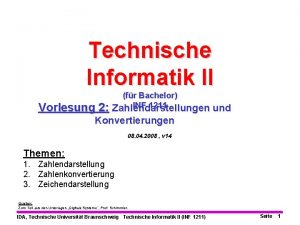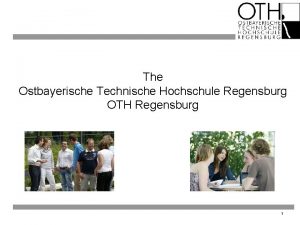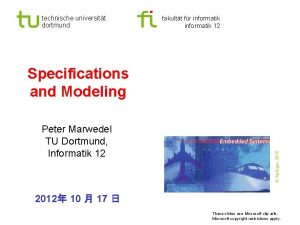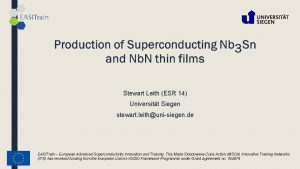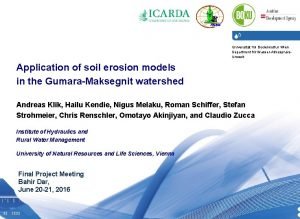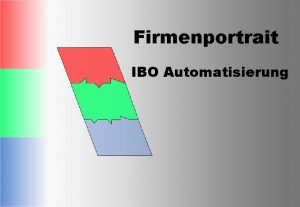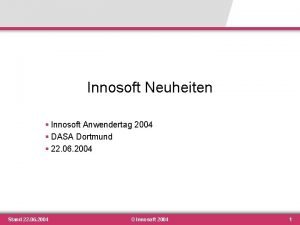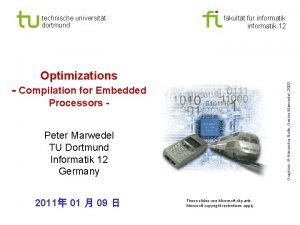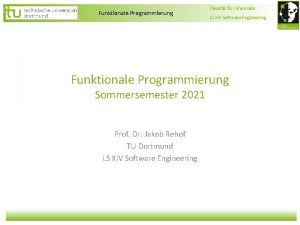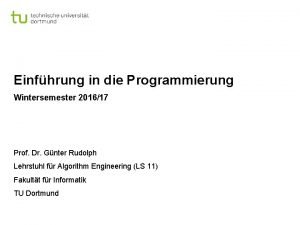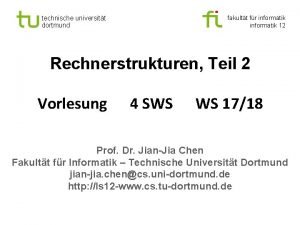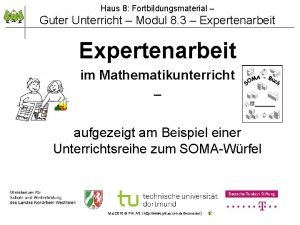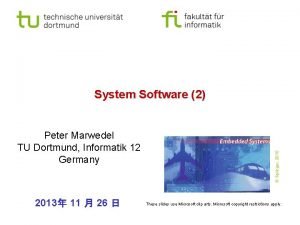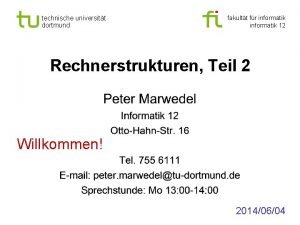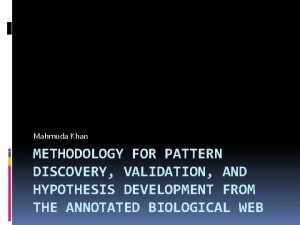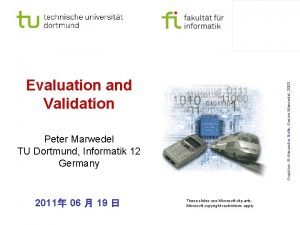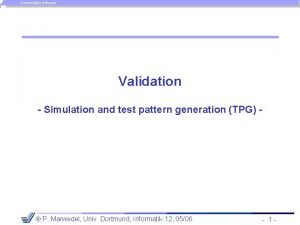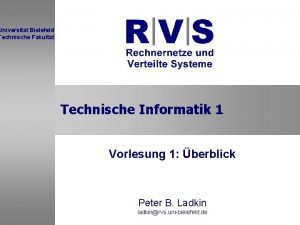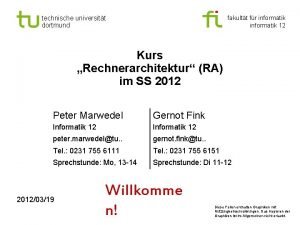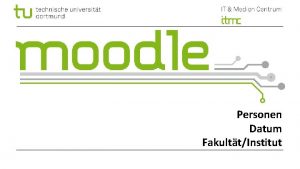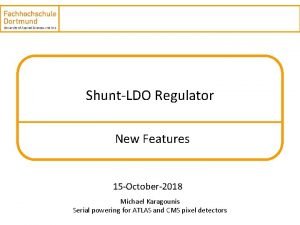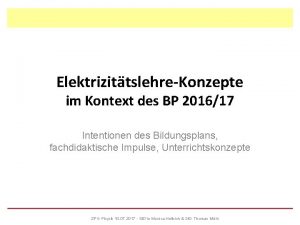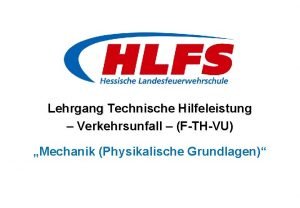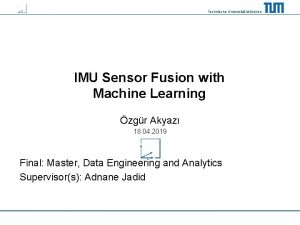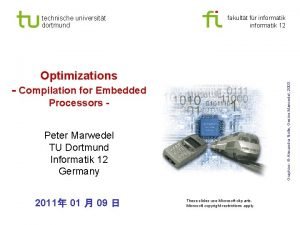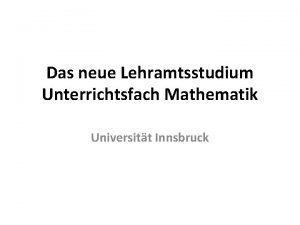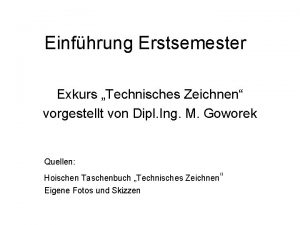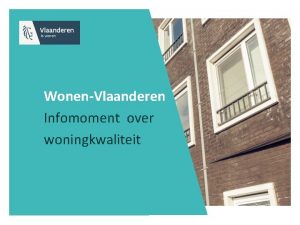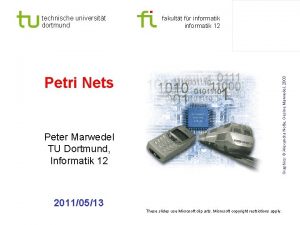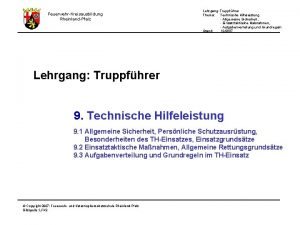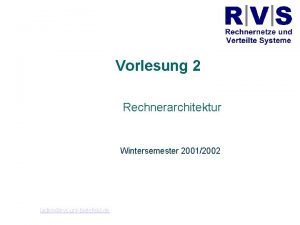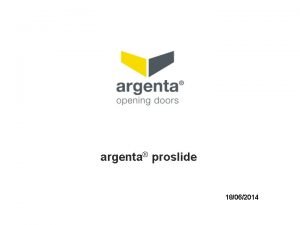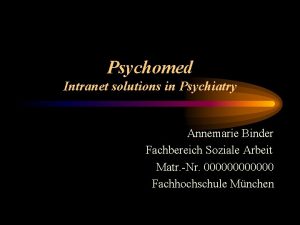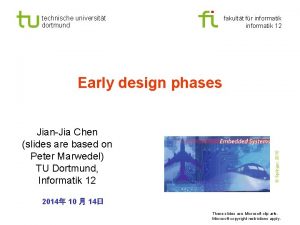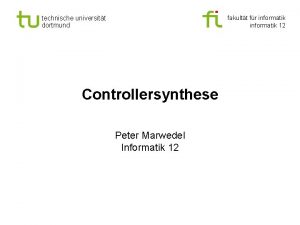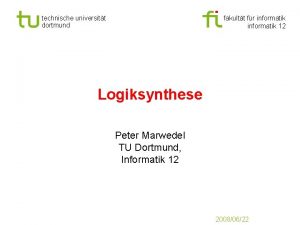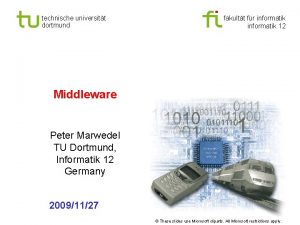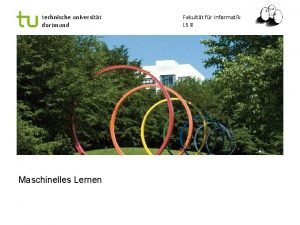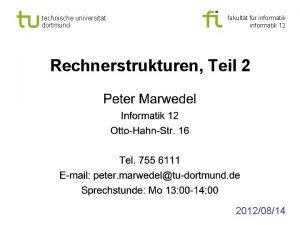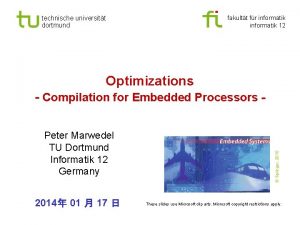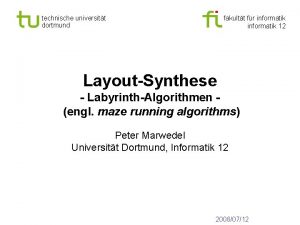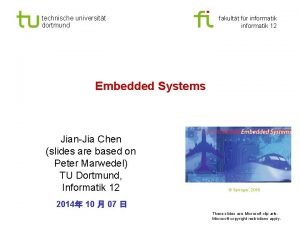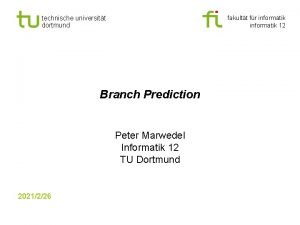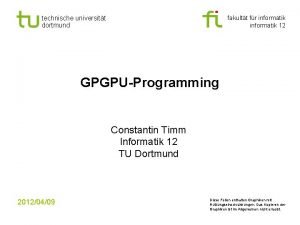technische universitt dortmund fakultt fr informatik 12 JianJia





























![General form of edge labels event [condition] / reaction Events: § Exist only until General form of edge labels event [condition] / reaction Events: § Exist only until](https://slidetodoc.com/presentation_image_h/1edfcca7d9b5ed8cbecceb0f5bfd3e7e/image-30.jpg)



















- Slides: 49

technische universität dortmund fakultät für informatik 12 Jian-Jia Chen (slides are based on Peter Marwedel) TU Dortmund, Informatik 12 © Springer, 2010 Early design phases 2014年 10 月 14日 These slides use Microsoft clip arts. Microsoft copyright restrictions apply.

Models of computation considered in this course Communication/ local computations Shared memory Undefined components Communicating finite state machines Data flow Message passing Synchronous | Asynchronous Plain text, use cases (Message) sequence charts State. Charts Kahn networks, SDF C/E nets, P/T nets, … Petri nets Discrete event (DE) model VHDL*, Verilog*, System. C*, … Von Neumann model C, C++, Java technische universität dortmund SDL fakultät für informatik Only experimental systems, e. g. distributed DE in Ptolemy C, C++, Java with libraries CSP, ADA | JJ Chen and P. Marwedel, Informatik 12, 2014 * Based on implementation of VHDL, Verilog. . - 2 -

Capturing the requirements as text § In the very early phases of some design project, only descriptions of the system under design (SUD) in a natural language such as English or Japanese exist. § Expectations for tools: • Machine-readable • Version management • Dependency analysis • Example: DOORS® [Telelogic/IBM] technische universität dortmund fakultät für informatik JJ Chen and P. Marwedel, Informatik 12, 2014 - 3 -

Use cases § Use cases describe possible applications of the SUD § Included in UML (Unified Modeling Language) § Example: Answering machine § Neither a precisely specified model of the computations nor a precisely specified model of the communication technische universität dortmund fakultät für informatik JJ Chen and P. Marwedel, Informatik 12, 2014 - 4 -

(Message) Sequence charts § Explicitly indicate exchange of information § One dimension (usually vertical dimension) reflects time § The other reflects distribution in space Example: technische universität dortmund § Included in UML § Earlier called Message Sequence Charts, now mostly called Sequence Charts fakultät für informatik JJ Chen and P. Marwedel, Informatik 12, 2014 - 5 -

Example (2) technische universität dortmund fakultät für informatik JJ Chen and P. Marwedel, Informatik 12, 2014 www. ist-more. org, deliverable 2. 1 - 6 -

Application: In-Car Navigation System Car radio with navigation system User interface needs to be responsive Traffic messages (TMC) must be processed in a timely way Several applications may execute concurrently technische universität dortmund fakultät für informatik JJ Chen and P. Marwedel, Informatik 12, 2014 © Thiele, ETHZ - 7 -

System Overview MMI Communication NAV RAD DB technische universität dortmund fakultät für informatik JJ Chen and P. Marwedel, Informatik 12, 2014 © Thiele, ETHZ - 8 -

Use case 1: Change Audio Volume < 200 ms MMI s 0 m <5 Communication NAV RAD DB technische universität dortmund fakultät für informatik JJ Chen and P. Marwedel, Informatik 12, 2014 © Thiele, ETHZ - 9 -

Use case 1: Change Audio Volume Communication Resource Demand technische universität dortmund fakultät für informatik JJ Chen and P. Marwedel, Informatik 12, 2014 © Thiele, ETHZ - 10 -

Use case 2: Lookup Destination Address < 200 ms MMI Communication NAV RAD DB technische universität dortmund fakultät für informatik JJ Chen and P. Marwedel, Informatik 12, 2014 © Thiele, ETHZ - 11 -

Use case 2: Lookup Destination Address technische universität dortmund fakultät für informatik JJ Chen and P. Marwedel, Informatik 12, 2014 © Thiele, ETHZ - 12 -

Time/distance diagrams as a special case No distinction between accidental overlap and synchronization technische universität dortmund fakultät für informatik JJ Chen and P. Marwedel, Informatik 12, 2014 - 13 -

© www. opentrack. ch Time/distance diagrams as a special case technische universität dortmund fakultät für informatik JJ Chen and P. Marwedel, Informatik 12, 2014 Levi-TDD - 14 -

UML: Timing diagrams Can be used to show the change of the state of an object over time. Other duty Professor preparation teaching Recording assistant recording editing Other duty Based on Scott Ambler, Agile Modeling, //www. agilemodeling. com, 2003 technische universität dortmund Approximately. . fakultät für informatik Mo JJ Chen and P. Marwedel, Informatik 12, 2014 Thu Mo Thu - 15 -

Summary § Motivation for non-von Neumann models § Support for early design phases • Text • Use cases • (Message) sequence charts technische universität dortmund fakultät für informatik JJ Chen and P. Marwedel, Informatik 12, 2014 - 16 -

technische universität dortmund fakultät für informatik 12 Jian-Jia Chen (slides are based on Peter Marwedel) TU Dortmund, Informatik 12 © Springer, 2010 State. Charts and State. Mates 2014年 10 月 14 日 These slides use Microsoft clip arts. Microsoft copyright restrictions apply.

Models of computation considered in this course Communication/ local computations Shared memory Undefined components Communicating finite state machines Data flow Message passing Synchronous | Asynchronous Plain text, use cases (Message) sequence charts State. Charts Kahn networks, SDF C/E nets, P/T nets, … Petri nets Discrete event (DE) model VHDL*, Verilog*, System. C*, … Von Neumann model C, C++, Java technische universität dortmund SDL fakultät für informatik Only experimental systems, e. g. distributed DE in Ptolemy C, C++, Java with libraries CSP, ADA | JJ Chen and P. Marwedel, Informatik 12, 2014 * Based on implementation of VHDL, Verilog. . - 18 -

State. Charts Classical automata not useful for complex systems (complex graphs cannot be understood by humans). Introduction of hierarchy State. Charts [Harel, 1987] State. Chart = the only unused combination of „flow“ or „state“ with „diagram“ or „chart“ Used here as a (prominent) example of a model of computation based on shared memory communication. appropriate only for local (non-distributed) systems technische universität dortmund fakultät für informatik JJ Chen and P. Marwedel, Informatik 12, 2014 - 19 -

Introducing hierarchy FSM will be in exactly one of the substates of S is active (either in A or in B or. . ) technische universität dortmund fakultät für informatik JJ Chen and P. Marwedel, Informatik 12, 2014 - 20 -

Definitions § Current states of FSMs are also called active states. § States which are not composed of other states are called basic states. § States containing other states are called super-states. § Super-states S are called OR-super-states, if exactly one of the sub-states of S is active whenever S is active. superstate substates technische universität dortmund fakultät für informatik JJ Chen and P. Marwedel, Informatik 12, 2014 - 21 -

Default state mechanism Try to hide internal structure from outside world! Default state Filled circle indicates sub-state entered whenever super-state is entered. Not a state by itself! technische universität dortmund fakultät für informatik JJ Chen and P. Marwedel, Informatik 12, 2014 - 22 -

History mechanism (behavior different from last slide) For input m, S enters the state it was in before S was left (can be A, B, C, D, or E). If S is entered for the first time, the default mechanism applies. technische universität dortmund fakultät für informatik JJ Chen and P. Marwedel, Informatik 12, 2014 - 23 -

Combining history and default state mechanism same meaning History and default mechanisms can be used hierarchically. technische universität dortmund fakultät für informatik JJ Chen and P. Marwedel, Informatik 12, 2014 - 24 -

Concurrency Convenient ways of describing concurrency req. AND-super-states: FSM is in all (immediate) sub-states of a super-state; Example: technische universität dortmund fakultät für informatik JJ Chen and P. Marwedel, Informatik 12, 2014 - 25 -

Entering and leaving AND-super-states Line-monitoring and key-monitoring are entered and left, when service switch is operated. technische universität dortmund fakultät für informatik JJ Chen and P. Marwedel, Informatik 12, 2014 - 26 -

Types of states In State. Charts, states are either § basic states, or § AND-super-states, or § OR-super-states. technische universität dortmund fakultät für informatik JJ Chen and P. Marwedel, Informatik 12, 2014 - 27 -

Timers Since time needs to be modeled in embedded & cyber-physical systems, timers need to be modeled. In State. Charts, special edges can be used for timeouts. If event a does not happen while the system is in the left state for 20 ms, a timeout will take place. technische universität dortmund fakultät für informatik JJ Chen and P. Marwedel, Informatik 12, 2014 - 28 -

Using timers in an answering machine . technische universität dortmund fakultät für informatik JJ Chen and P. Marwedel, Informatik 12, 2014 - 29 -
![General form of edge labels event condition reaction Events Exist only until General form of edge labels event [condition] / reaction Events: § Exist only until](https://slidetodoc.com/presentation_image_h/1edfcca7d9b5ed8cbecceb0f5bfd3e7e/image-30.jpg)
General form of edge labels event [condition] / reaction Events: § Exist only until the next evaluation of the model § Can be either internally or externally generated Conditions: § Refer to values of variables that keep their value until they are reassigned Reactions: § Can either be assignments for variables § or creation of events Example: § service-off [not in Lproc] / service: =0 technische universität dortmund fakultät für informatik JJ Chen and P. Marwedel, Informatik 12, 2014 - 30 -

The State. Charts simulation phases (State. Mate Semantics) How are edge labels evaluated? Three phases: 1. Effect of external changes on events and conditions is evaluated, 2. The set of transitions to be made in the current step and right hand sides of assignments are computed, 3. Transitions become effective, variables obtain new values. Separation into phases 2 and 3 enables a resulting unique (“determinate”) behavior. technische universität dortmund fakultät für informatik JJ Chen and P. Marwedel, Informatik 12, 2014 - 31 -

Example In phase 2, variables a and b are assigned to temporary variables: a’ : = b, b’ : = a; In phase 3, these are assigned to a and b. a : = a’, b : = b’; As a result, variables a and b are swapped. technische universität dortmund fakultät für informatik JJ Chen and P. Marwedel, Informatik 12, 2014 - 32 -

Example (2) In a single phase environment, executing the left state first would assign the old value of b (=0) to a and b: a : = 0, b : = 0; Executing the right state first would assign the old value of a (=1) to a and b. b : = 1, a : = 1; The result would depend on the execution order. technische universität dortmund fakultät für informatik JJ Chen and P. Marwedel, Informatik 12, 2014 - 33 -

Reflects model of clocked hardware a b In an actual clocked (synchronous) hardware system, both registers would be swapped as well. Same separation into phases found in other languages as well, especially those that are intended to model hardware. technische universität dortmund fakultät für informatik JJ Chen and P. Marwedel, Informatik 12, 2014 - 34 -

Steps Execution of a State. Mate model consists of a sequence of (status, step) pairs Status= values of all variables + set of events + current time Step = execution of the three phases (State. Mate semantics) e phas 1 phase 3 Status technische universität dortmund Other implementations of phase 2 State. Charts do not have these 3 phases (and hence could lead to different results)! fakultät für informatik JJ Chen and P. Marwedel, Informatik 12, 2014 - 35 -

Lifetime of events Events live until the step following the one in which they are generated (“one shot-events“). technische universität dortmund fakultät für informatik JJ Chen and P. Marwedel, Informatik 12, 2014 - 36 -

Other semantics Several other specification languages for hierarchical state machines (UML, dave, …) do not include three simulation phases. These correspond more to a SW point of view with no synchronous clocks. Some systems allow turning the multi-phased simulation on and off. technische universität dortmund fakultät für informatik JJ Chen and P. Marwedel, Informatik 12, 2014 - 37 -

Broadcast mechanism Values of variables are visible to all parts of the State. Chart model. New values become effective in phase 3 of the current step and are obtained by all parts of the model in the following step. ! State. Charts implicitly assumes a broadcast mechanism for variables ( implicit shared memory communication –other implementations would be very inefficient -). State. Charts is appropriate for local control systems ( ), but not for distributed applications for which updating variables might take some time ( ). technische universität dortmund fakultät für informatik JJ Chen and P. Marwedel, Informatik 12, 2014 - 38 -

Determinate vs. deterministic § Kahn (1974) calls a system determinate if we will always obtain the same result for a fixed set (and timing) of inputs § Others call this property deterministic However, this term has several meanings: • Non-deterministic finite state machines • Non-deterministic operators (e. g. + with non-deterministic result in low order bits) • Behavior not known before run-time (unknown input results in non-determinism) • In the sense of determinate as used by Kahn In order to avoid confusion, we use the term “determinate“ in this course. technische universität dortmund fakultät für informatik JJ Chen and P. Marwedel, Informatik 12, 2014 - 39 -

Conflicts Techniques for resolving these conflicts wanted technische universität dortmund fakultät für informatik JJ Chen and P. Marwedel, Informatik 12, 2014 - 40 -

State. Charts determinate or not? Must all simulators return the same result for a given input? § Separation into 3 phases a required condition § Semantics State. Mate semantics may be non-determinate Potential other sources of non-determinate behavior: § Choice between conflicting transitions resolved arbitrarily: Tools typically issue a warning if such a situation could exist Determinate behavior for State. Mate semantics if transition conflicts are resolved and no other sources of undefined behavior exist technische universität dortmund fakultät für informatik JJ Chen and P. Marwedel, Informatik 12, 2014 - 41 -

Evaluation of State. Charts (1) Pros ( ): § Hierarchy allows arbitrary nesting of AND- and OR-super states. § (State. Mate-) Semantics defined in a follow-up paper to original paper. § Large number of commercial simulation tools available (State. Mate, State. Flow, Better. State, . . . ) § Available “back-ends“ translate State. Charts into SW or HW languages, thus enabling software or hardware implementations. technische universität dortmund fakultät für informatik JJ Chen and P. Marwedel, Informatik 12, 2014 - 42 -

technische universität dortmund fakultät für informatik 12 Jian-Jia Chen (slides are based on Peter Marwedel) TU Dortmund, Informatik 12 © Springer, 2010 Backups 2014年 10 月 14日 These slides use Microsoft clip arts. Microsoft copyright restrictions apply.

Use case 3: Receive TMC Messages MMI <1 000 ms Communication NAV RAD DB technische universität dortmund fakultät für informatik JJ Chen and P. Marwedel, Informatik 12, 2014 © Thiele, ETHZ - 44 -

Use case 3: Receive TMC Messages technische universität dortmund fakultät für informatik JJ Chen and P. Marwedel, Informatik 12, 2014 © Thiele, ETHZ - 45 -

Life Sequence Charts* (LSCs) Key problems observed with standard MSCs: During the design process, MSC are initially interpreted as “what could happen” (existential interpretation, still allowing other behaviors). Later, they are frequently assumed to describe “what must happen” (referring to what happens in the implementation). * W. Damm, D. Harel: LSCs: Breathing Life into Message Sequence Charts, Formal Methods in System Design, 19, 45– 80, 2001 technische universität dortmund fakultät für informatik JJ Chen and P. Marwedel, Informatik 12, 2014 - 46 -

Extensions for LSCs (1) t r a h e-c Extension 1: Pr Introduction of precharts: Pre-charts describe conditions that must hold for the main chart to apply. Prof Mic Cam TA Recorder test confirms press Example: technische universität dortmund fakultät für informatik JJ Chen and P. Marwedel, Informatik 12, 2014 - 47 -

Extensions (2) Extension 2: Mandatory vs. provisional behavior Level Mandatory (solid lines) Provisional (dashed lines) Chart All runs of the system satisfy the chart At least one run of the system satisfies the chart Location Instance must move beyond location/time If message is sent, it will be received Instance run need not move beyond loc/time Receipt of message is not guaranteed Message Condition must be met; otherwise abort technische universität dortmund fakultät für informatik If condition is not met, exit subchart JJ Chen and P. Marwedel, Informatik 12, 2014 - 48 -

(Message) Sequence Charts PROs: § Appropriate for visualizing schedules, § Proven method for representing schedules in transportation. § Standard defined: ITU-TS Recommendation Z. 120: Message Sequence Chart (MSC), ITU-TS, Geneva, 1996. § Semantics also defined: ITU-TS Recommendation Z. 120: Message Sequence Chart (MSC)—Annex B: Algebraic Semantics of Message Sequence Charts, ITU-TS, Geneva. CONS: § describes just one case, no timing tolerances: "What does an MSC specification mean: does it describe all behaviors of a system, or does it describe a set of sample behaviors of a system? ” * * H. Ben-Abdallah and S. Leue, “Timing constraints in message sequence chart specifications, ” in Proc. 10 th International Conference on Formal Description Techniques FORTE/PSTV’ 97, Chapman and Hall, 1997. technische universität dortmund fakultät für informatik JJ Chen and P. Marwedel, Informatik 12, 2014 - 49 -
 Technische informatik 2 tu bs
Technische informatik 2 tu bs Oth regensburg exchange
Oth regensburg exchange Rechnerstrukturen tu dortmund
Rechnerstrukturen tu dortmund Harvard universitt
Harvard universitt Universitt freiburg
Universitt freiburg Universitt wien
Universitt wien Universitt
Universitt Ostrzenski
Ostrzenski Technische lego
Technische lego Dortmund arbeitslosenquote
Dortmund arbeitslosenquote E3t tu dortmund
E3t tu dortmund Innosoft einsatzplanung
Innosoft einsatzplanung Memory z dortmund
Memory z dortmund Funktionale programmierung tu dortmund
Funktionale programmierung tu dortmund Holger schmidt fh dortmund
Holger schmidt fh dortmund Retina tu dortmund
Retina tu dortmund Tu dortmund rechnerstrukturen
Tu dortmund rechnerstrukturen Pikas uni dortmund
Pikas uni dortmund Valutierend
Valutierend Studentensekretariat tu dortmund
Studentensekretariat tu dortmund Srp tu dortmund
Srp tu dortmund Rechnerstrukturen tu dortmund
Rechnerstrukturen tu dortmund Ub dortmund
Ub dortmund Lsf fh dortmund
Lsf fh dortmund Aufzug im brandfall nicht benutzen rechtsgrundlage
Aufzug im brandfall nicht benutzen rechtsgrundlage Thermico dortmund
Thermico dortmund Zubair khan dortmund
Zubair khan dortmund Boss tu dortmund
Boss tu dortmund Alexandra nolte
Alexandra nolte Dortmund pattern
Dortmund pattern Hazardfehler
Hazardfehler Rechnerarchitektur tu dortmund
Rechnerarchitektur tu dortmund Tu dortmund unimaik
Tu dortmund unimaik Michael karagounis
Michael karagounis Www.biologiepagina.nl- indeling plantenrijk
Www.biologiepagina.nl- indeling plantenrijk Gerätekunde technische hilfeleistung
Gerätekunde technische hilfeleistung Fahrradkettenmodell
Fahrradkettenmodell Mechanik
Mechanik Technische universität münchen (tum)
Technische universität münchen (tum) Die gruppe im technischen hilfeleistungseinsatz
Die gruppe im technischen hilfeleistungseinsatz Technische graphics
Technische graphics Technische mathematik innsbruck
Technische mathematik innsbruck Zentrierbohrung vereinfachte darstellung
Zentrierbohrung vereinfachte darstellung Woningkwaliteit
Woningkwaliteit Technische graphics
Technische graphics Spreizwinkel feuerwehr
Spreizwinkel feuerwehr Stage technische informatica
Stage technische informatica Uni bielefeld technische fakultät
Uni bielefeld technische fakultät Argenta proslide
Argenta proslide Technische voraussetzungen intranet
Technische voraussetzungen intranet
